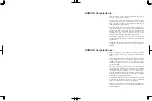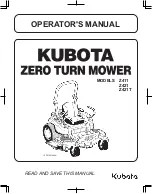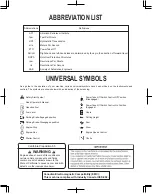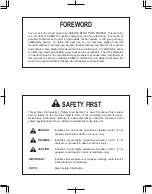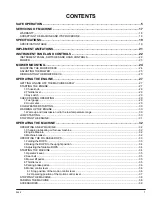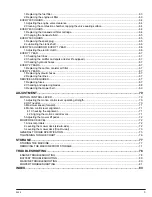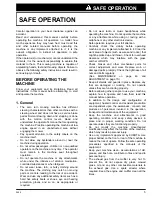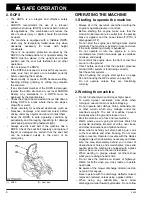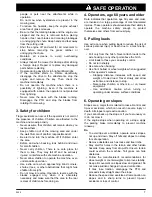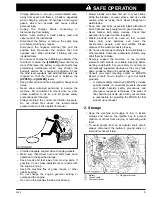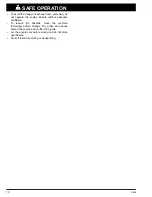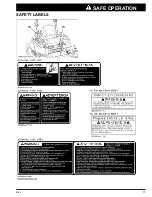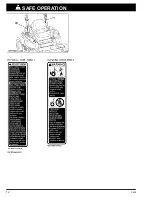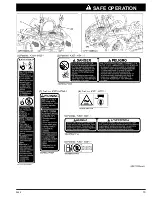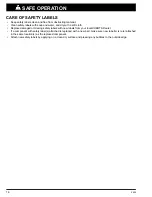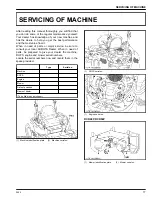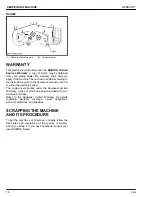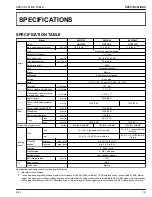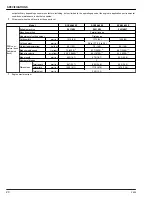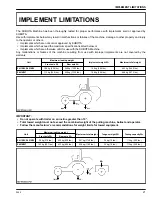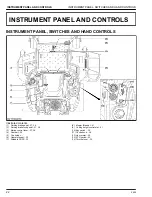
• Use special caution when changing direction on
slopes. Slow down, and use extra caution when
changing direction on a slope.
Do not
• Do not turn on slopes unless necessary. If
necessary, turn uphill slowly and gradually.
• Do not mow near drop-offs, ditches, or
embankments. The mower could suddenly turn
over if a wheel is over the edge of cliff or ditch, or if
an edge caves in.
• Do not mow on wet grass. Reduced traction could
cause sliding and loss of control.
• Do not try to stabilize the machine by putting your
foot on the ground.
• Do not use the grass catcher on steep slopes.
• Do not start or stop suddenly on slopes. If tires lose
traction, disengage the PTO and proceed slowly
straight down the slope.
• Never
“freewheel”
. Do not let the machine travel
downhill with motion control levers at the neutral
lock position or in neutral.
• Do not operate the machine without the mower
deck installed.
7. Stopping the machine
• Park the machine on level ground.
• Make sure that the machine and all attachments
have come to a complete stop before you get off.
• Before you get off, apply the parking brake, place
the motion control levers in their neutral lock
positions,
disengage
the
PTO,
lower
all
attachments to the ground, turn off the engine, and
remove the key.
• Do not park the machine on dry grass or leaves.
TRANSPORTING THE MACHINE
• Disengage
power
to
attachment(s)
when
transporting or not in use.
• Do not tow this machine. Use a suitable truck or
trailer when transporting on public roads.
• Use extra care when loading or unloading the
machine into a trailer or truck. Use full width ramps
for loading machine into a trailer or truck.
• This machine is not allowed to be used on public
roads.
• Shut off fuel while storing or transporting.
• Tie the machine down securely using straps,
chains, cables, or ropes.
• Both front and rear straps should be directed down
and outward from the machine.
SERVICING AND STORAGE
1. Servicing the machine
• Before servicing, park the machine on a firm, level
surface and apply the parking brake. Remove the
key to prevent an accidental start-up.
• Allow the machine time to cool before touching the
engine, muffler and so on.
• Always stop the engine before refueling. Avoid
spills and overfilling. Wipe up spilled fuel
immediately.
(1) Fuel tank cap
• Use extra care when handling gasoline fuels. They
are flammable.
1. Use only an approved container.
2. Do not remove the fuel cap or refuel with the
engine running. Allow the engine to cool before
refueling. Do not smoke while refueling or when
standing near fuel.
3. Do not refuel the machine indoors and always
clean up spilled fuel or oil.
4. Do not store the machine or fuel container
inside where there is an open flame, such as in
a water heater.
• Do not smoke when working around battery or
when refueling. Extinguish all cigarettes, cigars,
pipes, and other sources of ignition. Keep all sparks
and flames away from battery and fuel tank.
• Never fill containers inside a vehicle or on a truck or
trailer bed with a plastic liner. Always place
containers on the ground away from your vehicle
before filling.
• Remove equipment from the truck or trailer and
refuel it on the ground. If this is not possible, then
refuel such equipment with a portable container,
rather than from a fuel dispenser nozzle. Keep the
nozzle in contact with the rim of the fuel tank or
container opening at all times until fueling is
complete. Do not use a nozzle lock open device.
• If fuel is spilled on clothing, change the clothing
immediately. Replace the fuel cap and tighten
securely.
SAFE OPERATION
8
Z400
Summary of Contents for Z411
Page 3: ...OPERATOR S MANUAL 1SFRT00108A01 READ AND SAVE THIS MANUAL MODELS Z411 Z421 Z421T ...
Page 9: ...4 Z400 ...
Page 16: ...SAFETY LABELS SAFE OPERATION Z400 11 ...
Page 17: ...SAFE OPERATION 12 Z400 ...
Page 18: ...SAFE OPERATION Z400 13 ...
Page 19: ...SAFE OPERATION 14 Z400 ...
Page 20: ...SAFE OPERATION Z400 15 ...
Page 53: ...PERIODIC SERVICE CHART LABEL MAINTENANCE PERIODIC SERVICE CHART LABEL 48 Z400 ...


